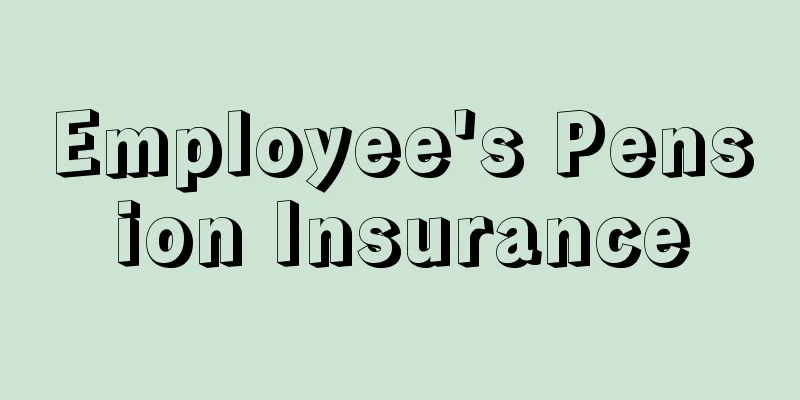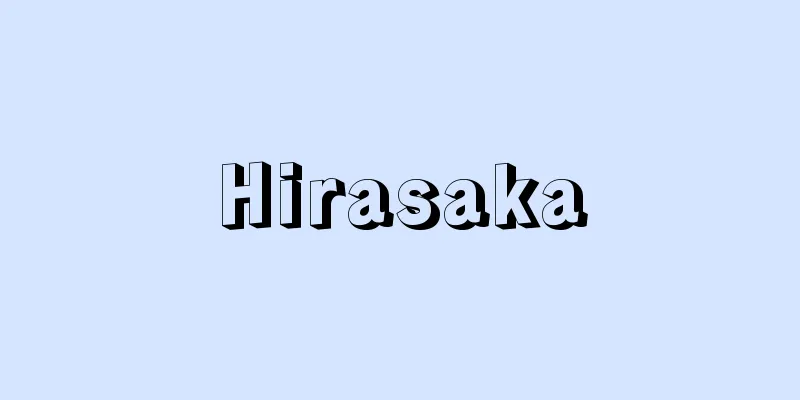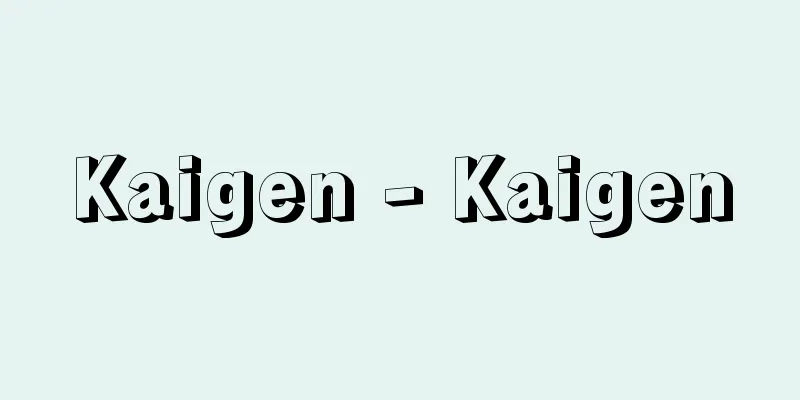Employee's Pension Insurance

|
One of Japan's public pension systems, it is a second-tier pension system that is paid proportionally to earnings and is applied to employed workers, including civil servants, on top of the basic pension common to all citizens. It is abbreviated as Kounen. [Yasuhiko Yamazaki November 13, 2020] HistoryThe first public pension system for private sector workers was the Seamen's Insurance Law, enacted in 1939 (Showa 14) for seamen and put into effect the following year in 1940. The first public pension system for land-based workers was the Workers' Pension Insurance Law, enacted in 1941 for male factory workers and put into effect the following year in 1942. In 1944, the law was amended to include clerical staff and women, and its name was changed to the Employees' Pension Insurance Law. Employees' Pension Insurance ceased to function for a time after the Second World War due to the economic and social turmoil, but was rebuilt in 1954 (Showa 29). After that, during the period of high economic growth, benefits were improved with the aim of reaching the level of developed countries, and in particular, the 1973 amendment included a reevaluation of past compensation, which is the basis for calculating pension amounts, and the adoption of a price indexation system. Then, in the 1980s, there was a demand for the equalization and stabilization of the public pension system as a whole in response to a society with a declining birthrate and an aging population. In the 1985 reform, a basic pension common to all citizens was introduced, and with this, Employees' Pension Insurance, together with Mutual Aid Pension Insurance, came to play the role of a second-tier pension system, paying pensions proportional to earnings on top of the basic pension. Since this reform, the keynote of the reform has been the suppression of benefits in order to mitigate future increases in the burden. The following are the main points of subsequent reforms. (1) 1994 Amendment: The age at which the fixed portion of the pension is paid was gradually raised from 60 to 65 (for men from 2001 to 2013, and for women from 2006 to 2018). Insurance premiums were exempted during childcare leave. (2) 1996 Amendment: The pensions of the Japan Railway Mutual Aid Association (JR Mutual Aid Association), the Nippon Telegraph and Telephone Mutual Aid Association (NTT Mutual Aid Association), and the Japan Tobacco Mutual Aid Association (JT Mutual Aid Association) were integrated into the Employees' Pension Insurance. (3) 2000 Amendment: The age at which the salary-proportional portion of the pension begins to be paid will be gradually raised from 60 to 65 (for men, from 2013 to 2025, and for women, from 2018 to 2030), the level of the salary-proportional portion of the pension will be reduced by 5%, and pension amount revisions after age 65 will be consolidated into a price indexation system. (4) 2001 Amendment: The pensions of the Agriculture, Forestry and Fishery Organization Employees Mutual Aid Association were integrated into the Employees' Pension Insurance. (5) 2004 Amendment: Introduction of a macroeconomic sliding system that fixes the final insurance premium and automatically adjusts the benefit level, and introduction of pension division upon divorce. (6) 2012 Amendment: The expansion of employee insurance coverage to part-time workers, exemption from insurance premiums during maternity leave, and unification of employee pensions by expanding the coverage of employees' pension insurance to civil servants, etc. (7) 2016 Amendment: Expansion of employee insurance coverage to part-time workers, revision of pension adjustment rules, etc. (8) 2020 (Reiwa 2) Amendments: Expanding the scope of employee insurance to part-time workers, etc., reviewing the method of receiving pensions while employed, expanding the options for when to start receiving pensions, etc. [Yasuhiko Yamazaki November 13, 2020] Insured personEmployees' Pension Insurance applies to workplaces and ships that meet certain requirements, and insured persons are people under the age of 70 who are employed there. Compulsory application workplaces are workplaces and ships that employ five or more full-time employees, and corporate workplaces that employ full-time employees. Private workplaces with fewer than five employees, and private workplaces with five or more employees such as some service industries, agriculture, and fishing, are not subject to compulsory application, but can become voluntary application workplaces if the employer obtains the consent of more than half of the employees. With regard to the applicability of part-time workers, in recent years, there has been progress in expanding the scope of employee insurance, and (1) from October 2016, the scope will be expanded to part-time workers in companies with 501 or more employees who meet certain requirements, such as a weekly scheduled working time of 20 hours or more and a monthly income of 88,000 yen or more; (2) from April 2017, companies with 500 or fewer employees will be able to apply the insurance to part-time workers on a company-by-company basis based on labor-management agreement (national and local governments will apply the insurance regardless of size); (3) from October 2022, the scope will be expanded to companies with 100 or more employees, and from October 2024, to companies with 50 or more employees. [Yasuhiko Yamazaki November 13, 2020] Overview of benefitsEmployees' pension insurance provides three types of benefits: old-age employees' pension, disability employees' pension/disability allowance, and survivors' employees' pension. In principle, these benefits are paid on top of the basic pension if the basic pension payment requirements are met, but the following benefits are unique to Employees' Pension Insurance and are paid separately from the basic pension: special old-age employees' pension paid before age 65 on a transitional basis, third-class disability employees' pension, disability allowance, and survivors' employees' pension for childless spouses, parents, grandparents, and grandchildren. While the basic pension is paid in a fixed amount, employees' pension benefits are paid according to the period of insured period and the salary received while employed. [Yasuhiko Yamazaki November 13, 2020] Old-age employees' pensionOld-age employees' pension is paid to those who have been insured under the employees' pension insurance and have met the qualification period for the basic old-age pension. The age at which payment begins is 65, but as a transitional measure, a special old-age employees' pension (fixed amount portion + salary-proportional portion) is paid before the age of 65. The transitional measure applies to those born before April 1, 1949 (Showa 24) for the fixed amount portion and before April 1, 1959 for the salary-proportional portion (women are paid 5 years later). Old-age employees' pension is paid in full when the insured person retires and loses his/her insured status, but if the person is still employed, part or all of the pension amount is suspended depending on the total amount of salary and pension. The amount of the old-age employees' pension is "salary-proportional portion + fixed amount portion (only for those under 65 years old) + additional pension amount". The amount of the salary-proportional portion is "average standard salary amount during the insured period x multiplier factor x number of months of the insured period". The average standard remuneration amount is calculated by replacing the remuneration, including bonuses, during the insured period with the current wage level. The fixed portion of the pension amount is calculated by multiplying the unit price by the number of months of the insured period, and is equivalent to the basic old-age pension after the age of 65. The additional pension amount is paid as a fixed amount to beneficiaries who have been insured for 20 years or more, or for 15 to 19 years after the age of 40 (35 for women), and who have a spouse and children who meet the requirements for their livelihood. [Yasuhiko Yamazaki November 13, 2020] Disability pension and disability allowanceDisability Employee's Pension is paid on top of the Basic Disability Pension when a disability (1st or 2nd grade) that falls under the Basic Disability Pension occurs due to an injury or illness that was first diagnosed during the insured period of the Employee's Pension Insurance. In addition, even if the disability does not fall under the disability grade of the Basic Disability Pension, if it falls under the disability grade of the Employee's Pension Insurance, a 3rd grade disability employees' pension or a disability allowance will be paid as a lump sum. The annual amount of the Disability Employee's Pension is based on the salary-proportional pension amount (average standard salary amount during the insured period x multiplying factor x number of months of the insured period), with 1st grade being 1.25 times that of 2nd grade and 1st and 2nd grades being increased by a spouse's allowance. The disability allowance is equivalent to two years' worth of the salary-proportional pension amount. [Yasuhiko Yamazaki November 13, 2020] Survivor's pensionSurvivor's Employee's Pension Insurance is paid to surviving family members who were supported by the insured person when the insured person of the Employee's Pension Insurance or the beneficiary of the Old Age Employee's Pension Insurance died. The scope of survivors includes surviving family members who are eligible for the Survivor's Basic Pension (spouse with children or children), spouse without children (conditions for husband will be described later), husband, parents, and grandparents who are 55 years old or older when the insured person dies (payment is made from age 60 for all), and grandchildren. In this case, children and grandchildren are unmarried children up to the end of the year in which they turn 18, and children under the age of 20 who have a disability of grade 1 or 2. The order of survivors to whom the Survivor's Employee's Pension Insurance is paid is (1) spouse and children, (2) parents, (3) grandchildren, and (4) grandparents. If the first person acquires the right to receive the pension, the next person will not be paid even if the first person loses the right to receive the pension. The amount of the survivor's pension is based on three-quarters of the salary-proportional pension amount, plus a middle-aged and elderly widow's allowance or a transitional widow's allowance if the beneficiary is the wife. [Yasuhiko Yamazaki November 13, 2020] Cost burdenThe cost of providing benefits under the Employee's Pension Insurance is covered by insurance premiums and investment income from reserve funds (which are partially used for insurance premiums). Insurance premiums are paid by the insured person and the employer, and are calculated by multiplying the insured person's standard monthly salary and standard bonus amount by the insurance premium rate. However, during the period of maternity leave from 42 days before birth to 56 days after birth, and during childcare leave until the child is three years old, the insured person and employer are exempt from paying insurance premiums, along with health insurance premiums. The standard monthly salary is a graded classification of all remuneration paid in exchange for labor (excluding temporary remuneration and bonuses received every three months or more) converted into hypothetical remuneration, with the 1st grade (lower limit) being 88,000 yen and the 32nd grade (upper limit) being 650,000 yen. The standard bonus amount is also capped at 1.5 million yen per payment. The insurance premium rate has been raised by 0.354% each year since the 2004 revision, but has been fixed at 18.3% since September 2017. [Yasuhiko Yamazaki November 13, 2020] "New Lecture Series on Social Security Law 1: Future Medical Care and Pensions" edited by the Japan Social Security Law Association (2012, Horitsu Bunkasha)" ▽ "Illustrated Guide to the Pension System, 6th Edition, edited by Mizuho Research Institute (2015, Toyo Keizai Inc.)" ▽ "History of the Japanese Public Pension System - 70 Years After the War and Half a Century of Universal Pensions" by Yoshihara Kenji and Hata Mitsuru (2016, Chuohoki Publishing)" ▽ "Prospects for the Pension System, edited by Tsubono Takeshi and compiled by the Pension Research Institute (2017, Toyo Keizai Inc.)" ▽ "Pension Strategies for the 100-Year Life Era" by Tamura Masayuki (2018, Nikkei Publishing Inc.)" ▽ "Explanation of the Amendments to the Pension System Strengthening Act" (2020, Social Insurance Research Institute)" ▽ "Overview of the Employees' Pension Insurance Act, October 2020 Edition" (2020, Social Insurance Research Institute) "Trends in Insurance and Pensions, compiled and published by the Health, Labor and Welfare Statistics Association, annual editions " "Guide to Social Insurance" and "Guide to Pensions, annual editions (Social Insurance Research Institute)" [Reference items] | | | |Employee's | | | | | |Source: Shogakukan Encyclopedia Nipponica About Encyclopedia Nipponica Information | Legend |
|
日本の公的年金制度の一つで、公務員を含む雇用労働者を対象とし、全国民共通の基礎年金に上乗せして支給される二階部分の報酬比例の年金制度。厚年(こうねん)と略称される。 [山崎泰彦 2020年11月13日] 沿革民間企業の労働者を対象とする最初の公的年金制度は、船員を対象に1939年(昭和14)に制定され、翌1940年に施行された船員保険法によるものであった。陸上労働者を対象とする最初の公的年金制度は、男子工場労働者を対象として1941年に制定され、翌1942年に施行された労働者年金保険法によるものである。同法は、1944年の改正により、適用対象が事務職員と女性にまで拡大され、名称も厚生年金保険法と改められた。厚生年金保険は、第二次世界大戦後しばらくの間、経済社会の混乱により機能停止していたが、1954年(昭和29)の全面改正により再建された。その後、高度経済成長期には先進国水準を目ざして給付改善が行われ、とくに1973年の改正では、年金額の算定基礎となる過去の報酬の再評価、物価スライド制の採用などが行われた。 その後1980年代に入ると、少子高齢化社会に対応した公的年金制度全体の公平化と安定化が要請されるようになった。1985年改正では全国民共通の基礎年金が導入され、これに伴って厚生年金保険は、共済年金とともに、基礎年金に上乗せして報酬比例の年金を支給する、二階部分の年金制度の役割を担うことになった。また、この改正以来、将来の負担増を緩和するための給付の抑制が改正の基調になっている。以下はその後の改正の主要事項である。 (1)1994年(平成6)改正 定額部分の支給開始年齢を60歳から65歳に段階的に引上げ(男性は2001年度から2013年度にかけて、女性は2006年度から2018年度にかけて)。育児休業期間中の保険料免除。 (2)1996年改正 日本鉄道共済組合(JR共済)、日本電信電話共済組合(NTT共済)、日本たばこ産業共済組合(JT共済)の年金を厚生年金へ統合。 (3)2000年(平成12)改正 報酬比例部分の支給開始年齢を60歳から65歳に段階的に引上げ(男性は2013年度から2025年度にかけて、女性は2018年度から2030年度にかけて)、報酬比例部分の年金水準の5%引下げ、65歳以後の年金額改定の物価スライドへの一本化。 (4)2001年改正 農林漁業団体職員共済組合の年金を厚生年金へ統合。 (5)2004年改正 最終保険料を固定したうえで給付水準を自動調整するマクロ経済スライド方式の導入、離婚時の年金分割の導入。 (6)2012年改正 短時間労働者に対する被用者保険の適用拡大、産休期間中の保険料免除、公務員等に厚生年金の適用を拡大する被用者年金一元化。 (7)2016年改正 短時間労働者に対する被用者保険の適用拡大、年金額改定ルールの見直しなど。 (8)2020年(令和2)改正 短時間労働者等に対する被用者保険の適用拡大、在職中の年金受給のあり方の見直し、受給開始時期の選択肢の拡大など。 [山崎泰彦 2020年11月13日] 被保険者厚生年金保険は、一定の要件に該当する事業所・船舶を適用事業所とし、そこに使用される70歳未満の者を被保険者としている。強制適用事業所は、常時5人以上の従業員を使用する事業所・船舶、および常時従業員を使用する法人の事業所である。5人未満の個人事業所と、5人以上であってもサービス業の一部や農業・漁業などの個人事業所は、強制適用の扱いを受けないが、事業主が従業員の2分の1以上の同意を得て、任意適用事業所となることができる。なお、短時間労働者の適用については、近年、被用者保険の適用拡大が進められており、(1)2016年10月から、501人以上の企業で、1週間の所定労働時間が20時間以上、月収8万8000円以上等の要件を満たす短時間労働者に適用拡大、(2)2017年4月から、従業員500人以下の企業で、労使の合意に基づき、企業単位で、短時間労働者への適用を可能とする(国・地方公共団体は、規模にかかわらず適用)、(3)2022年10月から、従業員100人以上の企業、2024年10月から50人以上の企業に適用拡大。 [山崎泰彦 2020年11月13日] 給付の概要厚生年金保険の給付は、老齢厚生年金、障害厚生年金・障害手当金、遺族厚生年金の3種類である。これらの給付は、基礎年金の支給要件を満たした場合に、原則として基礎年金に上乗せする形で支給されるが、経過的に65歳前に支給される特別支給の老齢厚生年金、3級の障害厚生年金、障害手当金、子のない配偶者・父母・祖父母・孫に対する遺族厚生年金は、基礎年金とは別に支給される厚生年金保険のみの独自給付である。支給額は、基礎年金が定額であるのに対して、厚生年金の給付は被保険者期間と在職中の報酬に応じて支給される。 [山崎泰彦 2020年11月13日] 老齢厚生年金老齢厚生年金は、厚生年金の被保険者期間を有する者で、老齢基礎年金の資格期間を満たした者に支給される。支給開始年齢は65歳であるが、経過措置として65歳前に特別支給の老齢厚生年金(定額部分+報酬比例部分)が支給される。経過措置の対象になるのは、定額部分は1949年(昭和24)4月1日以前生まれ、報酬比例部分は1959年4月1日以前生まれの者である(女性は5年遅れ)。老齢厚生年金は、退職して被保険者資格を喪失した場合には全額が支給されるが、在職している場合には報酬と年金の合計額に応じて年金額の一部または全部が支給停止される。老齢厚生年金の年金額は「報酬比例部分+定額部分(65歳未満に限る)+加給年金額」である。報酬比例部分の年金額は「被保険者期間中の平均標準報酬額×乗率×被保険者期間の月数」である。平均標準報酬額は、被保険者期間中の賞与を含む報酬を現在の賃金水準に置き換えて算出する。定額部分の年金額は「単価×被保険者期間の月数」で、65歳以後の老齢基礎年金に相当するものである。加給年金額は、被保険者期間が20年以上または40歳(女性は35歳)以降15年~19年の被保険者期間がある受給権者に生計を維持されている要件を満たした配偶者と子がいる場合に、定額で支給される。 [山崎泰彦 2020年11月13日] 障害厚生年金・障害手当金障害厚生年金は、厚生年金の被保険者期間中に初診日のある傷病が原因で、障害基礎年金に該当する障害(1級・2級)が生じたときに、障害基礎年金に上乗せして支給される。また、障害基礎年金の障害等級に該当しない程度の障害であっても、厚生年金の障害等級に該当するときは、3級の障害厚生年金または一時金として障害手当金が支給される。障害厚生年金の年金額は、報酬比例の年金額(被保険者期間中の平均標準報酬額×乗率×被保険者期間の月数)を基本として、1級は2級の1.25倍、1級と2級は配偶者加給が加算される。障害手当金は報酬比例の年金額の2年分相当額である。 [山崎泰彦 2020年11月13日] 遺族厚生年金遺族厚生年金は、厚生年金の被保険者が死亡したとき、老齢厚生年金の受給権者が死亡したときなどに、その者によって生計を維持していた遺族に支給される。遺族の範囲は、遺族基礎年金の支給対象となる遺族(子のある配偶者または子)、子のない配偶者(夫の条件については後述)、被保険者等が死亡したときに55歳以上である夫・父母・祖父母(いずれも60歳から支給)、孫である。この場合の子、孫とは、婚姻をしていない18歳到達年度の末日までの子および20歳未満であって障害の程度が1、2級の子である。遺族厚生年金が支給される遺族の順位は、(1)配偶者と子、(2)父母、(3)孫、(4)祖父母であり、先順位の者が受給権を取得すれば、その後に先順位の者が受給権を失っても、次順位の者には支給されない。遺族厚生年金の年金額は、報酬比例の年金額の4分の3を基本として、妻が受給権者の場合は、これに中高齢寡婦加算額または経過的寡婦加算額を加えた額である。 [山崎泰彦 2020年11月13日] 費用負担厚生年金保険の給付に要する費用は、保険料と積立金(保険料の一部を充当したもの)の運用収入によってまかなわれる。保険料は、被保険者の標準報酬月額と標準賞与額に保険料率を乗じて被保険者と事業主が折半負担する。ただし、産前42日産後56日までの休業期間中および、子が3歳になるまでの育児休業期間中については、被保険者および事業主の保険料が、健康保険料とともに免除される。なお、標準報酬月額とは、労働の対価として支払われるすべての報酬(ただし、臨時に受けるもの、3か月を超える期間ごとに受ける賞与等を除く)を仮定的な報酬に置き換えて等級区分したもので、1級(下限)8万8000円~32級(上限)65万円となっている。標準賞与額についても1回の支給につき150万円の上限がある。保険料率は、2004年改正以降毎年0.354%ずつ引き上げられてきたが、2017年9月以降は18.3%で固定されている。 [山崎泰彦 2020年11月13日] 『日本社会保障法学会編『新・講座社会保障法1 これからの医療と年金』(2012・法律文化社)』▽『みずほ総合研究所編著『図解 年金のしくみ』第6版(2015・東洋経済新報社)』▽『吉原健二・畑満著『日本公的年金制度史――戦後七〇年・皆年金半世紀』(2016・中央法規出版)』▽『坪野剛司監修、年金綜合研究所編『年金制度の展望』(2017・東洋経済新報社)』▽『田村正之著『人生100年時代の年金戦略』(2018・日本経済新聞出版社)』▽『『年金制度機能強化法の改正点の解説』(2020・社会保険研究所)』▽『『厚生年金保険法総覧 令和2年10月版』(2020・社会保険研究所)』▽『厚生労働統計協会編・刊『保険と年金の動向』各年版』▽『『社会保険のてびき』『年金のてびき』各年版(社会保険研究所)』 [参照項目] | | | | | | | | | |出典 小学館 日本大百科全書(ニッポニカ)日本大百科全書(ニッポニカ)について 情報 | 凡例 |
<<: The Disaster of Mining Taxes - Kozeino-ka
>>: Employee's pension fund - kouseinenkinkikin
Recommend
Susa (English spelling)
Located in the Khuzestan region in southwestern I...
Skirōn (English spelling) Skiron
…The Procrustean bed, which is still used today t...
Hazara - Hazara (English spelling)
A Mongolian ethnic group living in the mountainous...
Aircraft Carrier Task Force - Aircraft Carrier Task Force
…In Japan, the naval task force, a carrier battle...
Justice of the Peace
The judges (sometimes called magistrates) of the ...
Voter - Voter
〘 noun 〙① A person who has rights. ② Especially, a...
Pocket - Pocket (English spelling)
A small pouch for carrying money or small items. ...
Elan, M.
... Comprised of two parts, Part 1 "Boulevar...
Akashi Island Storehouse - Akashi Island Storehouse
…It first premiered at the Shintomiza Theatre in ...
Hudson's Bay Company
The British Chartered Company, which had a monopol...
Nomura [town] - Nomura
A former town in Higashiuwa District, southwestern...
Kannai (China)
…The Wei River Plain in Shaanxi Province, China. ...
Schlatter, Adolf
Born: August 16, 1852 in St. Gallen Died: May 19, ...
Oligarchy and oligarchy
…He can be considered the intellectual pioneer of...
Wakame (wakame) - Undaria pinnatifida
A brown algae belonging to the Laminariales order ...









